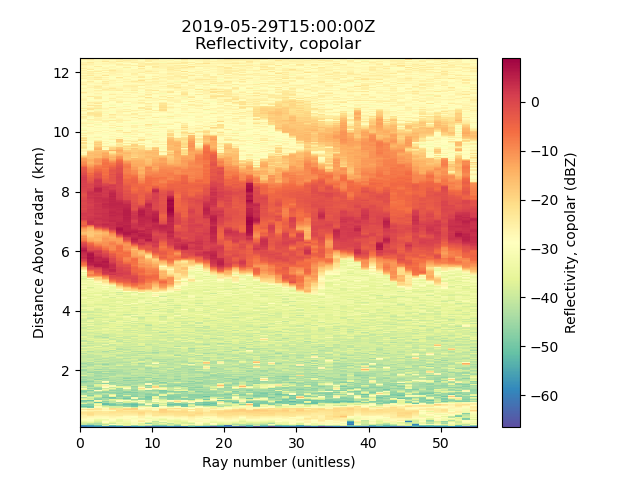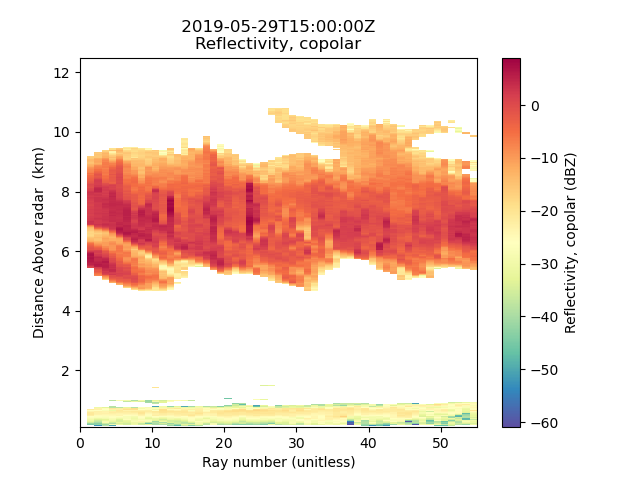Note
Go to the end to download the full example code.
Calculating and Plotting a Cloud Mask#
This example shows how to correct and plot reflectivity from an ARM KAZR using a noise floor cloud mask.
print(__doc__)
# Author: Adam Theisen and Zach Sherman
# License: BSD 3 clause
import matplotlib.pyplot as plt
import numpy as np
from open_radar_data import DATASETS
import pyart
Read and plot raw data
First let’s read and plot our dataset without any mask.
# Fetch and read in the ARM KAZR file.
filename = DATASETS.fetch("sgpkazrgeC1.a1.20190529.000002.cdf")
radar = pyart.aux_io.read_kazr(filename)
# Let's now take a look at reflectivity data prior to any corrections.
display = pyart.graph.RadarDisplay(radar)
display.plot("reflectivity_copol")
display.set_limits(xlim=(0, 55))
plt.show()

Calculate cloud mask and plot corrected data
Now lets apply a mask by using the calc_cloud_mask function that will use a noise floor calculation from range and more to calculate the mask.
# First lets correct the data by calculating the mask.
cloud_mask_radar = pyart.correct.calc_cloud_mask(radar, "reflectivity_copol", "range")
# In this new radar object we should now have a new cloud mask field.
print(cloud_mask_radar.fields["cloud_mask_2"])
# Next we'll create a copy of the reflectivity field so we are not
# overwriting the original data.
cloud_mask_radar.add_field_like(
"reflectivity_copol",
"reflectivity_cloud_mask",
cloud_mask_radar.fields["reflectivity_copol"]["data"].copy(),
)
# Now let's apply the mask to the copied reflectivity data.
cloud_mask_radar.fields["reflectivity_cloud_mask"]["data"][
cloud_mask_radar.fields["cloud_mask_2"]["data"] == 0
] = np.nan
# And now we can plot the masked reflectivity field.
display = pyart.graph.RadarDisplay(cloud_mask_radar)
display.plot("reflectivity_cloud_mask")
display.set_limits(xlim=(0, 55))
plt.show()

{'long_name': 'Cloud mask 2 (2D box)', 'units': '1', 'comment': 'The mask uses a 2D box to filter out noise.', 'flag_values': [0, 1], 'flag_meanings': ['no_cloud', 'cloud'], 'data': masked_array(
data=[[0, 0, 0, ..., 0, 0, 0],
[0, 0, 1, ..., 0, 0, 0],
[0, 1, 1, ..., 0, 0, 0],
...,
[0, 1, 1, ..., 0, 0, 0],
[0, 0, 1, ..., 0, 0, 0],
[0, 0, 0, ..., 0, 0, 0]],
mask=[[False, False, False, ..., False, False, False],
[False, False, False, ..., False, False, False],
[False, False, False, ..., False, False, False],
...,
[False, False, False, ..., False, False, False],
[False, False, False, ..., False, False, False],
[False, False, False, ..., False, False, False]],
fill_value=np.int64(999999),
dtype=int16)}
Total running time of the script: (0 minutes 0.749 seconds)